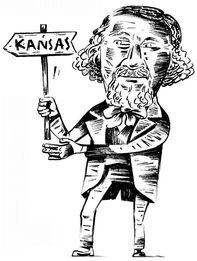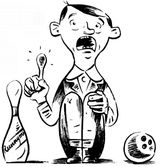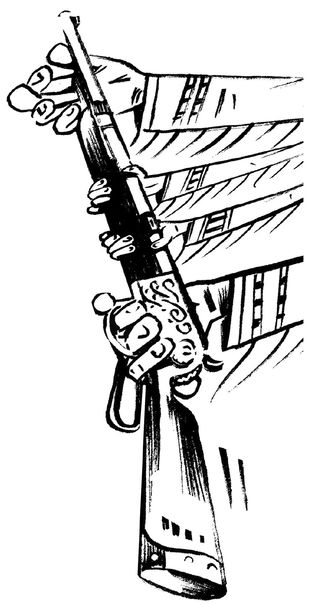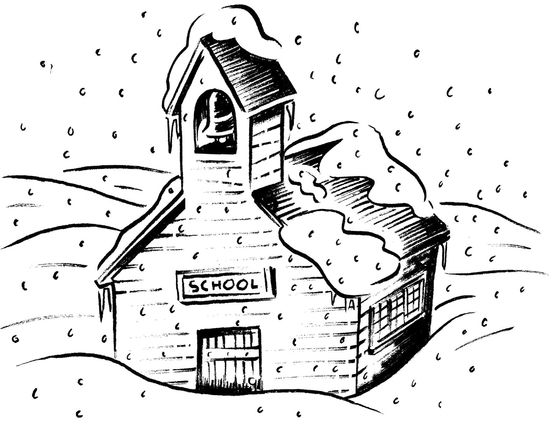Which Way to the Wild West? (20 page)
Read Which Way to the Wild West? Online
Authors: Steve Sheinkin

W
hile all this was happening, the massive movement of Americans from east to west was still going strongâthanks, in part, to Benjamin Singleton.
hile all this was happening, the massive movement of Americans from east to west was still going strongâthanks, in part, to Benjamin Singleton.
Singleton had escaped from slavery before the Civil War. Returning to the South after the war, he saw that former slaves had no real chance of improving their lives. White landowners simply refused to sell any land to black families.
Singleton came up with a plan. He started a settlement in Kansas, where land was still available to homesteaders. Then he printed posters and advertisements, sending them all over the South, inspiring thousands of African Americans to move west. They called themselves Exodusters (because they saw similarities between their story
and the biblical book of Exodus, in which the Israelite people escape from slavery).
and the biblical book of Exodus, in which the Israelite people escape from slavery).
Members of Congress started wondering why so many African American families were suddenly heading west. They called on Benjamin Singleton to testify before a Senate committee in 1880. Singleton told the senators he'd been leading black settlers to Kansas for seven years. “I believe I fetched out 7,432 people,” he said.
Senator:
How did you happen to send them out?
Singleton:
The first cause, do you mean, of them going?
Senator:
Yes.
Singleton:
Well, my people, for the want of landâwe needed land for our childrenâand their disadvantagesâthat caused my heart to grieve and sorrow; pity for my race, sir ⦠that caused me to go to work for them.
Senator:
You take all that responsibility on yourself?
How did you happen to send them out?
Singleton:
The first cause, do you mean, of them going?
Senator:
Yes.
Singleton:
Well, my people, for the want of landâwe needed land for our childrenâand their disadvantagesâthat caused my heart to grieve and sorrow; pity for my race, sir ⦠that caused me to go to work for them.
Senator:
You take all that responsibility on yourself?
Singleton:
I do ⦠and I think I have done a good deal of good, and I feel relieved!
I do ⦠and I think I have done a good deal of good, and I feel relieved!
Senator:
You are proud of your work?
You are proud of your work?
Singleton:
Yes, sir; I am!
Yes, sir; I am!
Benjamin Singleton

Historians aren't sure Singleton got the number (7,432) exactly right. But we do know he was a key leader of the Exoduster movement. And we know that thousands of Exodusters set out in search of new opportunities in the West.
Of course, they faced all the same challenges as other pioneersâgreater challenges, really, because as slaves they had never had the chance to save up any money. But like other pioneers, they were determined to start new lives on their own land. When one newspaper reporter asked an African American woman if the hardships might drive her back to the South, she said, “What, go back! Oh, no; I'd sooner starve here.”
An Exoduster named Williana Hickman had a slightly different reaction when her wagon first rattled into Kansas. She heard her husband and men in nearby wagons shouting: “There is Nicodemus!”
Battered and exhausted from the journey, Hickman was relieved to finally be arriving at Nicodemus, a town founded recently by black pioneers. She looked out from the wagon. There was nothing in sight but flat, open grassland.
“Where is Nicodemus?” she asked. “I don't see it.”
Her husband pointed ahead to a few snake-like curls of smoke rising from holes in the ground. “That is Nicodemus,” he said.
And she realized what he meant. Everyone in town was living underground in dugouts. “The scenery was not at all inviting,” she said.
The scenery changed quickly, though. Ten years later Nicodemus was a thriving town, with newspapers, hotels, churches, stores (including an ice cream shop), and a baseball team.
T
owns were popping up all over the Great Plains those days. Maybe the strangest of them was Runnymede, Kansas, founded by an immigrant from Britain named Ned Turnly. Actually, it wasn't so much a town as a get-rich-quick scheme.
owns were popping up all over the Great Plains those days. Maybe the strangest of them was Runnymede, Kansas, founded by an immigrant from Britain named Ned Turnly. Actually, it wasn't so much a town as a get-rich-quick scheme.
Turnly traveled around Britain, meeting with rich parents and offering to take their sons to America to teach them how to farmâfor a fee of five hundred pounds. Lots of families liked the idea of sending their spoiled young men off to learn about real work.
Of course, the sons had no interest in busting their backs on the plains of Kansas. So Turnly took them aside and said:
Never mind the farming. Come to America with me and you can hunt and play sports all day.
The young men were eager to sign up.
Never mind the farming. Come to America with me and you can hunt and play sports all day.
The young men were eager to sign up.
About a hundred of them arrived in Runnymede with their rifles, their favorite hunting dogs, and lots of spending money. They quickly set up horseracing tracks, a polo field, tennis courts, and fox hunts (though they usually hunted jackrabbits, which were easier to find).
While other pioneers were battling grasshoppers and droughts and prairie fires, these men faced dangers of their own, as one local newspaper reported: “Mr. Horace Capel had a rather nasty accident in the bowling alley the other eveningâhe got his thumb jammed between one of the pins and a ball.” Poor Horace lost his fingernail and needed a few stitches. “From the latest reports we hear he is progressing favorably,” the paper assured readers.
It was even riskier to join the town's football club (soccer, as we call it). Curious to see this imported sport, a reporter from a nearby town came to a game at Runnymede. He watched men run around kicking a ball, though to him the whole thing looked like an enormous wrestling match. “It was startling to witness them throw one another around violently,” he reported. “How many of them escaped serious injury is a mystery to the writer.”

The fun didn't last, though. Runnymede's whole economy was based on money from families back in Britainâand when the families heard what their boys were up to in America, they stopped sending money. That was the end of Runnymede.
But other towns all over the West (places with less bowling, more working) continued to grow. Nat Love saw the whole thing happen from the saddle of his horse. Still working as a cowboy, still riding the long cattle drives, Love watched the wide-open spaces of the West fill up with settlers. “The immense cattle ranges, stretching away in the distance as far as the eye could see, now began to be dotted with cities and towns,” Love said.
“To us wild cowboys of the range,” he added, “the new order of things did not appeal.”
S
itting Bull would probably have agreed. The Lakota chief had spent several years in Canada, but food was always hard to find. Besides, he wanted to go home. In the summer of 1881, riding bony horses and wearing ragged clothes, Sitting Bull and about forty families crossed the border to the United States.
itting Bull would probably have agreed. The Lakota chief had spent several years in Canada, but food was always hard to find. Besides, he wanted to go home. In the summer of 1881, riding bony horses and wearing ragged clothes, Sitting Bull and about forty families crossed the border to the United States.
All the Plains Indians were living on reservations now. Sitting Bull knew that he too must go to a reservation and turn himself in. For a man of tremendous pride, this was the toughest act of his life. In fact, he couldn't bring himself to hand over his rifle to American soldiers. Instead, he had his son Crow Foot (five years old) hand over the weapon.
“I surrender this rifle to you through my young son, whom I now desire to teach in this manner that he has become a friend of the Americans ⦠. I wish it to be remembered that I was the last man of my tribe to surrender my rifle.”
Then he tried to settle into life on the reservation. This wasn't easy, since the government kept coming up with new plans to carve off pieces of Indian reservations and open the land to settlers. After being forced to move five times by the government, one chief joked bitterly: “I think you had better put the Indians on wheels, and you can run them about whenever you wish.”

At shrinking reservations all over the West, government agents tried to persuade Indians to plant crops and raise cattle. The Americans put Sitting Bull to work digging a garden, which he found incredibly boring. He expressed his feelings in a song:
A warrior I have been
Now it is all over
A hard time I have
Now it is all over
A hard time I have
Finally Sitting Bull got permission to travel around a bit by train (he couldn't leave the reservation without a government pass). He saw some towns, toured some factories, made some speeches. And he was somewhat surprised to see huge crowds following him everywhereâhe hadn't realized he was one of the most famous people in America. Fame didn't really impress Sitting Bull, though he liked when people paid him to sign autographs.
Then life in the new America got even weirder for Sitting Bull. In 1885 a showman (and former buffalo hunter) named William “Buffalo Bill” Cody invited the Lakota chief to join Buffalo Bill's Wild West Show. The show claimed to give audiences in eastern cities a look at what life used to be like in the West. Sitting Bull's role in the show was to set up a tepee and ride around on a horse in his traditional clothing.
The show traveled from city to city, playing to sold-out theaters. Sitting Bull was making a great salary, plus extras from selling autographs and photos. He never got rich, though. He handed out most of his money to poor children he met on the streets of American cities.
After a year of touring, Sitting Bull got sick of show business. He went back home to the Plainsâback to the boring life on the Standing Rock Indian Reservation.
N
o, the West just wasn't as exciting as it used to be. Unless you count the weather.
o, the West just wasn't as exciting as it used to be. Unless you count the weather.
Take January 12, 1888, for example. The sun was shining at noon, and it was unusually warm. A schoolboy named O. W. Coursey was having fun with his friends outside their Dakota schoolhouse.
“We were all out playing in our shirt sleeves,” said Coursey, “without hats or mittens. Suddenly we looked up and saw something coming rolling toward us with great fury from the northwest, and making a loud noise.”

It looked to Corsey like mountains of cotton tumbling through the air, heading right for them. The children dove into the schoolhouse just as the blizzard slammed into the building, nearly knocking it over.
This massive storm of snow and wind swept across the plains, sending temperatures diving to twenty below zero. So many kids were at school when the storm hit that it became known as the School Children's Blizzard. Suddenly stuck in dark, freezing schoolhouses, many students tried to run for homeâa very bad idea. The swirling snow turned the entire world white. Kids got hopelessly lost just a few feet from the building.
A nineteen-year-old teacher named Minnie Freeman didn't have the option of staying inside. When the blizzard hit her Nebraska schoolhouse it ripped off the door and sent the roof spinning into the sky. Freeman knew her seventeen students could not live long without shelter. She quickly tied them together with a long piece of string, then led them out into the icy wind. “How it cut and almost blinded them!” she said. “It was terrible on their eyes.”
They stumbled and felt their way forward for nearly a mile. Amazingly, though she couldn't see more than a foot in front of her, Freeman was able to find a nearby farmhouse. She became a national celebrity for her heroism that day. (She got eighty marriage proposals in the mail.) Others were not so lucky. More than two hundred people died in the storm, many of them children who got lost trying to get home.
As settlers on the Great Plains were learning, these kinds of blizzards could strike at any time during the long winter. This changed life in the West, because ranchers got sick of losing their animals in
storms. The cattle would wander off and their hooves would get frozen to the ground. Unable to move, they would freeze or starve to death before the ranchers could find them.
storms. The cattle would wander off and their hooves would get frozen to the ground. Unable to move, they would freeze or starve to death before the ranchers could find them.
To protect their herds, ranchers started fencing in their land with a new invention: barbed wire. Farmers were doing the same thing. And the West was gradually divided up into fenced-in farms and ranches.
Other books
Watcher by Grace Monroe
A Death by Stephen King
Confessions from the Principal's Chair by Anna Myers
Pee Wee Pool Party by Judy Delton
The Little Drummer Girl by John le Carre
The Murder of Princess Diana by Noel Botham
Twinned by Galloway, Alice Ann
Dead Dreams ((Young Adult Paranormal Romance) ( Dead Dreams Trilogy)) by Michelle Wright
Just Curious by Jude Devereaux